It looks like you're using an Ad Blocker.
Please white-list or disable AboveTopSecret.com in your ad-blocking tool.
Thank you.
Some features of ATS will be disabled while you continue to use an ad-blocker.
share:
reply to post by otherpotato
Ohhh,I'd like to hear the answers for that question.
I have a friend who swears by freezer after proper drying. Got seed in dry storage and freezer, will let you know what germinates.
Ohhh,I'd like to hear the answers for that question.
I have a friend who swears by freezer after proper drying. Got seed in dry storage and freezer, will let you know what germinates.
Been a crazy planting day here. Expecting rain tomorrow, so tried to get as much work in as I could. 18 tomato plants. Cucumbers galore, 24 greasy
grit pole bean hills with tobacco stick teepees preset. Transplanted lemon balm, rosemary, curly parsley, Seeded basil, marigold, Transplanted 9 best
of the rescued volunteer tomatoes from my roma patch. Got about 48 up and in little pods right before last weekends freeze, and been tempering in and
out of the house ever since. Set out 3 zuke and 3 yellow straight neck squash. Weeded around last years potato patch that has 4 really strong
volunteers. And so glad I covered the strawberry bed, the blooms are getting the little green nubs, can't wait for their fruit. May not have enough
for a batch of jam this year but may buy extra and blender then dehydrate for fruit leather and plain dehydrating pieces.
Question....how much damage are the cicadas going to do? Would the oil water and soap repellant work to keeping from munching my tender young plants? They are expected to be done by end of June into July. So hope they don't stunt the growth too terribly.
Question....how much damage are the cicadas going to do? Would the oil water and soap repellant work to keeping from munching my tender young plants? They are expected to be done by end of June into July. So hope they don't stunt the growth too terribly.
They don't eat anything. Come out of the ground mate and die. Had the same batch 2 years ago here and other than being loud and driving the hens
crazy they have little impact. Media always over does it. They do attract huge harmless wasps called cicada killers that look like something that used
to battle Godzilla in those old 60's films.
If you concerned about young trees and the females burrowing into them to lay eggs simple floating row covers will prompt them to move to larger trees-they prefer locust trees the bigger the better.
The never ending discussions about cicada wasp killers and if they are true wasp or not. I say they are but just as many will say they are not.
Great fishing bait for carp.
If you concerned about young trees and the females burrowing into them to lay eggs simple floating row covers will prompt them to move to larger trees-they prefer locust trees the bigger the better.
The never ending discussions about cicada wasp killers and if they are true wasp or not. I say they are but just as many will say they are not.
Great fishing bait for carp.
reply to post by SunflowerStar
Last year was my first attempt at seed collection. I saved peas by letting them dry in the pod in a tin pan. Then I shelled them and put them in a plastic bag. I planted them this spring and they are growing as well as the commercial kind I planted. You would never be able to tell them apart. The proof will be in the pods this summer.
I think I am pea obsessed. They are my favorite thing to grow. They're nearly a foot tall right now.
Last year was my first attempt at seed collection. I saved peas by letting them dry in the pod in a tin pan. Then I shelled them and put them in a plastic bag. I planted them this spring and they are growing as well as the commercial kind I planted. You would never be able to tell them apart. The proof will be in the pods this summer.
I think I am pea obsessed. They are my favorite thing to grow. They're nearly a foot tall right now.
edit on 16-5-2013 by otherpotato because:
(no reason given)
reply to post by SunflowerStar
What zone are you in? We always start our curcurbitacae from seed. I never have had good luck transplanting them.
What zone are you in? We always start our curcurbitacae from seed. I never have had good luck transplanting them.
reply to post by hoochymama
Aquaponics is great! Built my system over winter and cycled it this spring. Have bluegill and catfish. My cabbages, kohlrabi and onions are thriving in AP. Just made/ate Kohl-slaw tonight! Broccoli is a great plant to cycle with if water temps are between 60-70F (prevents bolting, but ultimately depends on the varietal) . I have also incorporated mycology into the in-ground gardens and things have taken off. Mushrooms (Wine Caps) and wood chips makes plants explode! Particularly the nightshades; peppers, tomatoes, eggplants.
J.B.
Aquaponics is great! Built my system over winter and cycled it this spring. Have bluegill and catfish. My cabbages, kohlrabi and onions are thriving in AP. Just made/ate Kohl-slaw tonight! Broccoli is a great plant to cycle with if water temps are between 60-70F (prevents bolting, but ultimately depends on the varietal) . I have also incorporated mycology into the in-ground gardens and things have taken off. Mushrooms (Wine Caps) and wood chips makes plants explode! Particularly the nightshades; peppers, tomatoes, eggplants.
J.B.
I found a lemon tree! At last. A myers lemon that's a nice size. We have named him Vincent. Already bloomed and has loads of tiny green lemons
everywhere. Fingers crossed that this works out. He's set up in our kitchen window until it's safe to transition outside for the summer.
This has been an interesting week for the garden. Our last frost came this week. Got the warning for Monday night and so covered everything up - no frost. No warning for Tuesday night, didn't cover, got the frost. My granddmother, in her infinite yet day late-dollar-short wisdom advised that frost usually follows the second day of the warning. Thought I'd pass that along.
We fared OK. Some of the potatoes lost some leaves so they'll be delayed. A few of the tomatoes got crispy and we lost two, but everything else held up. I have put a firm stake in the ground now - nothing tender stays outside before May 15, no matter how many 80 degree days we may have before that date. New England weather is just far too temperamental. No wonder us New Englanders are too!
I'll be doing some more seeding today - second sowing of lettuce, spinach, beans. Picked up some red onion sets on a whim. I don't expect much from them at this point and haven't heard good things about sets but will sort through the bag and choose a few for planting.
Oh and nutsedge weeding - again.
Peas are flourishing.
I'll be posting my update in the research project later today, once I've exhausted the daylight. Shout out to woodsmom for being the first poster!
This has been an interesting week for the garden. Our last frost came this week. Got the warning for Monday night and so covered everything up - no frost. No warning for Tuesday night, didn't cover, got the frost. My granddmother, in her infinite yet day late-dollar-short wisdom advised that frost usually follows the second day of the warning. Thought I'd pass that along.
We fared OK. Some of the potatoes lost some leaves so they'll be delayed. A few of the tomatoes got crispy and we lost two, but everything else held up. I have put a firm stake in the ground now - nothing tender stays outside before May 15, no matter how many 80 degree days we may have before that date. New England weather is just far too temperamental. No wonder us New Englanders are too!
I'll be doing some more seeding today - second sowing of lettuce, spinach, beans. Picked up some red onion sets on a whim. I don't expect much from them at this point and haven't heard good things about sets but will sort through the bag and choose a few for planting.
Oh and nutsedge weeding - again.
Peas are flourishing.
I'll be posting my update in the research project later today, once I've exhausted the daylight. Shout out to woodsmom for being the first poster!
reply to post by otherpotato
I know that citrus loves WARM, and am concerned about dormancy issues, I have many things around here that the climate isn't hot enough. It tends to take these I have in mind several months to get going again, so for you its possible the citrus might respond the same way...
However it just occurred to me that maybe an 'indoor greenhouse' might be something. I can't say I recall seeing this, but in the right window, a sort of indoors cold frame might just mean a quite hot box for heat loving plants. This comes to mind as I know how cold it can be near windows when its dead cold outside. Constructed with the right materials, and asset strategy (nearby heat vents etc), it could even still look quite nice.
I know that citrus loves WARM, and am concerned about dormancy issues, I have many things around here that the climate isn't hot enough. It tends to take these I have in mind several months to get going again, so for you its possible the citrus might respond the same way...
However it just occurred to me that maybe an 'indoor greenhouse' might be something. I can't say I recall seeing this, but in the right window, a sort of indoors cold frame might just mean a quite hot box for heat loving plants. This comes to mind as I know how cold it can be near windows when its dead cold outside. Constructed with the right materials, and asset strategy (nearby heat vents etc), it could even still look quite nice.
edit
on 18-5-2013 by IgnoranceIsntBlisss because: (no reason given)
I found that some of the baby onions I had bought are sprouting green stems in my refrigerator. Garlic does this too for me but not in fridge. It
seems things only grow for me in this fashion. I don't want to let this opportunity slip by but am afraid to plant them for fear of screwing this
bloom up. Usually things grow fine until I plant them for some reason. Maybe last time I planted them upside down or not deep enough (I assume the
stems should be sticking out). Or a change in environment shocks them and kills them. Some people have a way with these things and I'd like to begin
learning. Other forums are for experts and this one said questions are ok. Any advice would help.
Originally posted by Dianec
I found that some of the baby onions I had bought are sprouting green stems in my refrigerator. Garlic does this too for me but not in fridge. It seems things only grow for me in this fashion.
There are a lot of variables here as to why they won't grow. I'll try to give you a few pointers as best I can.
I don't want to let this opportunity slip by but am afraid to plant them for fear of screwing this bloom up. Usually things grow fine until I plant them for some reason. Maybe last time I planted them upside down or not deep enough (I assume the stems should be sticking out).
Everything from soil temp to soil pH to even placement can have an effect, as well as time of the year you put them in. Generally you don't weant really cold soil, or heavily acidic soil, as things just won't take. Generally with onions, if they are sprouting, take off the outside layers, and only plant the core of the vegetable in the ground. Having the sprout in or out of the ground shouldn't matter, but I'd put it underground. Onions are one of those amazing things where you can simply plant the peelings, and each year they should sprout given the right soil conditions.
To give your plants the best chance, you really need good fertilizer, potting or growing soil and water to get going. I tend to find when I'm putting in cuttings or peelings, place a little lucerne hay, or even compost or mulch in the base of the hole, then put a bit of water in. This gives the plants a bit of insulation, plus keeps the water close to the root system. Then use potting/growing soil, then cover with the original soil over the top. Make sure you fertilise (I use Seasol for veggies), and they should take.
Or a change in environment shocks them and kills them. Some people have a way with these things and I'd like to begin learning. Other forums are for experts and this one said questions are ok. Any advice would help.
Position is also a big factor. Most seedlings don't need constant sun, but I find half and half (half a days sun, half a days shade) is best for any vegies. You also don't want to put them where they are exposed to too much wind or weather. If you have no choice, putting up shades in certain positions or screens to guard (remember guard, not block) the most of the weather, they should also be good.
Gardening is all really trial and error, especially for an amatuer gardner. Figure out what works best for you, and stick with it, or change it as neccessary.
Hope this helps a bit.
edit on 19/5/2013 by 74Templar because: eta
edit on 19/5/2013 by 74Templar because: laaaaayers....
Onions have layers...
PEAS!
First blossoms this week. This one popped on Monday and we have three other full blossoms today with many more gearing up.
Wahoo....
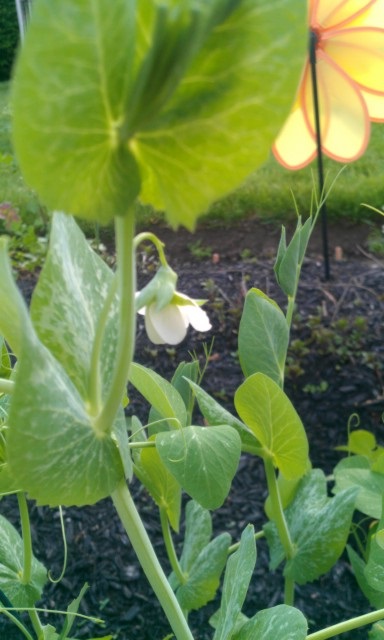
First blossoms this week. This one popped on Monday and we have three other full blossoms today with many more gearing up.
Wahoo....

Tomatoes are planted and are doing well.
Hoping to get some cukes in tomorrow.
My rhubarb is doing better this year so far.
Hoping to get some cukes in tomorrow.
My rhubarb is doing better this year so far.
One of the things I'm doing out here this summer is an old farming technique called trench or spot field placement. This allowed farmers to rotate
crops within a field. This allowed them to save mileage on their most precious machine at the time-their work horses and mules.
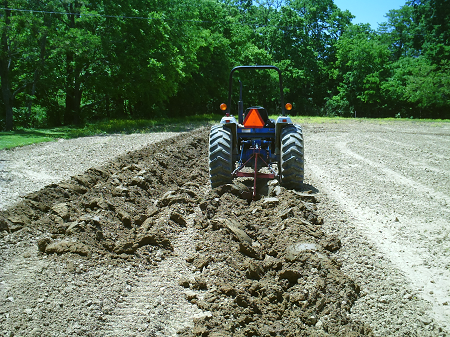
This was last years red okra field turned and planted in a turnip cover crop-then turned again to allow the turnips to rot in the ground.

After clearing the trenches I added granulated lime and tilled it deep into the trenches.

Then I started adding my compost.

This is after preparing the trenches I started planting tomatoes-60 to a row-10 rows-600 in all.

Second row because of the high quality fertile nature of the trench I can plant closer together.
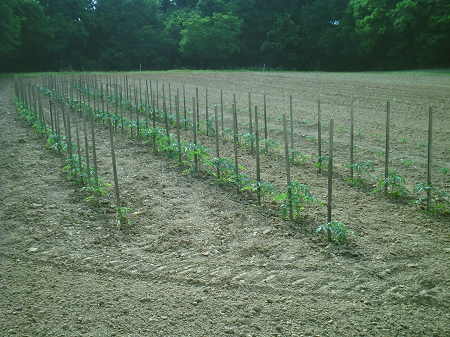
This is how they looked yesterday about 375 so far. I going to do a demonstration on proper staking, suckering and tying as soon as I am caught up.
Some other things:

Vagabond Tom Cat I named Bighead who shows up every now and then. I am trying to learn how to use the micro lens on this camera. Still a little blurry however I am making progress.
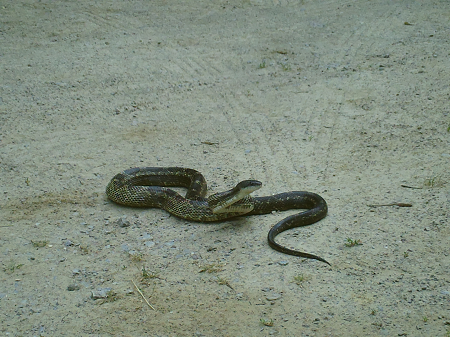
Gray Rat snake (Pantherophis spiloides) who also made an appearance.
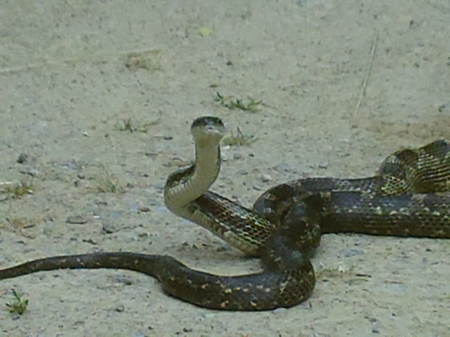
The centuries old species war continues as the same snake in Carolina is know as Elaphe obsoleta spiloides. I think Texas classifies it Species: E. obsoleta Subspecies: E. o. spiloides
More to come

This was last years red okra field turned and planted in a turnip cover crop-then turned again to allow the turnips to rot in the ground.

After clearing the trenches I added granulated lime and tilled it deep into the trenches.

Then I started adding my compost.

This is after preparing the trenches I started planting tomatoes-60 to a row-10 rows-600 in all.

Second row because of the high quality fertile nature of the trench I can plant closer together.

This is how they looked yesterday about 375 so far. I going to do a demonstration on proper staking, suckering and tying as soon as I am caught up.
Some other things:

Vagabond Tom Cat I named Bighead who shows up every now and then. I am trying to learn how to use the micro lens on this camera. Still a little blurry however I am making progress.

Gray Rat snake (Pantherophis spiloides) who also made an appearance.

The centuries old species war continues as the same snake in Carolina is know as Elaphe obsoleta spiloides. I think Texas classifies it Species: E. obsoleta Subspecies: E. o. spiloides
More to come
I did a garden update in the research project, and you can find the linky
here.
No reason to cross post, I'll just provide links.
No reason to cross post, I'll just provide links.
How I spent my late May/early June:
WEEDING.
AND WEEDING.
AND WEEDING AGAIN.
Trying to go au naturelle takes a lot of work. Like an hour a day. But before you can beat them...you have to join them.
I've learned a lot about the weeds in my garden. When to weed and how. Which ones piss off the other plants. Which ones are edible. Which ones help the plants I want. And which ones are just a nuisance.
Don't favor cosmetics! Be aggressive. And for god's sake, get your hands dirty. Or get out of the garden.
WEEDING.
AND WEEDING.
AND WEEDING AGAIN.
Trying to go au naturelle takes a lot of work. Like an hour a day. But before you can beat them...you have to join them.
I've learned a lot about the weeds in my garden. When to weed and how. Which ones piss off the other plants. Which ones are edible. Which ones help the plants I want. And which ones are just a nuisance.
Don't favor cosmetics! Be aggressive. And for god's sake, get your hands dirty. Or get out of the garden.
backtoedenfilm.com...
A friend sent me this link to a film the other day, I found it very interesting, the guy threw away his rotor tiller, and all he uses is a rake. He uses wood chips to start his gardens and as mulch, has minimal weeds. His produce is all huge and from what the people in the film say very sweet. Its got a bit of religion in it, but not to much.
A friend sent me this link to a film the other day, I found it very interesting, the guy threw away his rotor tiller, and all he uses is a rake. He uses wood chips to start his gardens and as mulch, has minimal weeds. His produce is all huge and from what the people in the film say very sweet. Its got a bit of religion in it, but not to much.
I posted my latest update in the survival gardening research thread. It's all about the ubiquitous weed called nutsedge. Please
learn from my pain if you are dealing with this bugger.
They don't call it "nuts edge" for nothing.
They don't call it "nuts edge" for nothing.
The old-timers called nutsedge 'shiny grass' and there remedy was similar to many of their weed problems-goats. A small acre or 2 section would be
fenced off and given the billygoat approach. They would eat, paw, dig, trample, squish everything in their pen. They love any kind of tuber and can
easily paw down a foot or more after them. This was especially effective during their rut-or a goats version of it.
In years when the fruit trees would lose their fruit due to late frost-1 out of every 5 years or so-they would fence them off and billygoat em'. I was always amazed at how fast they can turn a weed infected pasture into a moonscape. That fall the entire section would be planted down in fescue and any remaining tubers would be choked out by the aggressive nature of the young grass that spring.
An excellent presentation in the research thread however I am somewhat confused by the two separate threads.
In years when the fruit trees would lose their fruit due to late frost-1 out of every 5 years or so-they would fence them off and billygoat em'. I was always amazed at how fast they can turn a weed infected pasture into a moonscape. That fall the entire section would be planted down in fescue and any remaining tubers would be choked out by the aggressive nature of the young grass that spring.
An excellent presentation in the research thread however I am somewhat confused by the two separate threads.
reply to post by spooky24
Thanks... I love the goats! I wish I could try that strategy. Though I'm not sure I can convince my family we should get goats. I'll have to work on that.
The difference: This thread is open to anyone who would like to contribute/share/ask questions etc. It's informal sharing of information.
The other thread (in the research forum) is only open to members of the research project until the project is completed.
Here's some information about the intent of the Research Forum and how it works: A Guide to the Research Forum
I started this thread first and then realized it might be a good topic for a project. It works having both because this one is open for participation to everyone who's interested, while the forum thread won't be open for comment until October/November. Plus the research forum forces a person to put in a little extra effort.
Thanks... I love the goats! I wish I could try that strategy. Though I'm not sure I can convince my family we should get goats. I'll have to work on that.
The difference: This thread is open to anyone who would like to contribute/share/ask questions etc. It's informal sharing of information.
The other thread (in the research forum) is only open to members of the research project until the project is completed.
Here's some information about the intent of the Research Forum and how it works: A Guide to the Research Forum
I started this thread first and then realized it might be a good topic for a project. It works having both because this one is open for participation to everyone who's interested, while the forum thread won't be open for comment until October/November. Plus the research forum forces a person to put in a little extra effort.
new topics
-
Paradox of Progress
Ancient & Lost Civilizations: 5 hours ago -
Joe Biden gives the USA's Highest Civilian Honor Award to Hillary Clinton and George Soros.
US Political Madness: 7 hours ago -
Winter Storm
Fragile Earth: 8 hours ago -
Biden Face Planted Somewhere
Politicians & People: 10 hours ago -
A great artist and storyteller, for kids of all ages
General Entertainment: 10 hours ago
top topics
-
Joe Biden gives the USA's Highest Civilian Honor Award to Hillary Clinton and George Soros.
US Political Madness: 7 hours ago, 13 flags -
What Is 'Quad Demic'? Mask Mandate Returns In These US States
Diseases and Pandemics: 14 hours ago, 11 flags -
Volcano Watch 2025
Fragile Earth: 16 hours ago, 8 flags -
The Future of fashion .
Social Issues and Civil Unrest: 15 hours ago, 8 flags -
Winter Storm
Fragile Earth: 8 hours ago, 7 flags -
Bin Cyber Junk…
Short Stories: 15 hours ago, 6 flags -
Biden Face Planted Somewhere
Politicians & People: 10 hours ago, 5 flags -
A great artist and storyteller, for kids of all ages
General Entertainment: 10 hours ago, 5 flags -
Paradox of Progress
Ancient & Lost Civilizations: 5 hours ago, 5 flags -
The Undertones - Teenage Kicks
Music: 16 hours ago, 3 flags
active topics
-
Winter Storm
Fragile Earth • 19 • : RazorV66 -
Post A Funny (T&C Friendly) Pic Part IV: The LOL awakens!
General Chit Chat • 7988 • : KrustyKrab -
What Is 'Quad Demic'? Mask Mandate Returns In These US States
Diseases and Pandemics • 29 • : TheRickestRick -
Paradox of Progress
Ancient & Lost Civilizations • 3 • : BingoMcGoof -
Here we again... CHINA having mass outbreak of something
Diseases and Pandemics • 24 • : NoCorruptionAllowed -
A great artist and storyteller, for kids of all ages
General Entertainment • 1 • : angelchemuel -
-@TH3WH17ERABB17- -Q- ---TIME TO SHOW THE WORLD--- -Part- --44--
Dissecting Disinformation • 3931 • : RelSciHistItSufi -
Joe Biden gives the USA's Highest Civilian Honor Award to Hillary Clinton and George Soros.
US Political Madness • 29 • : caterpillage -
NJ Drones tied to Tesla explosion at Trump Las vegas
General Conspiracies • 45 • : glen200376 -
New Jersey-Teachers Can Now Be Certified Without Passing Basic Reading Writing Math Testing
Education and Media • 14 • : boatguy12
